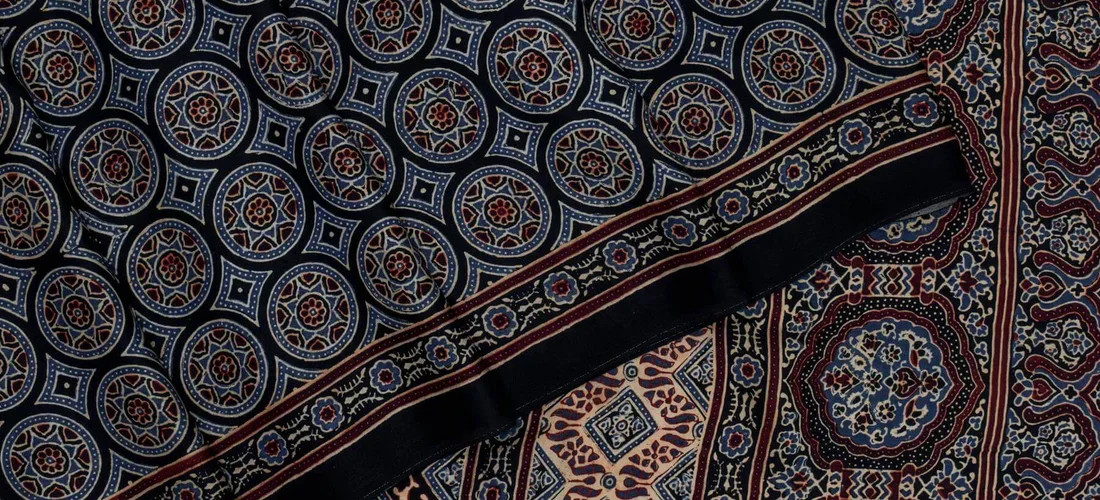In a small, sunlit courtyard in Sindh, an elderly woman named Rukhsana carefully washes her cherished Ajrakh shawl. She remembers the day her grandmother gifted it to her, a symbol of love and tradition passed down through generations. As Rukhsana gently tends to the delicate fabric, she knows that caring for Ajrakh is not just about preserving a piece of cloth, but about honoring the rich heritage and artistry it represents. This story, dear reader, is about how you too can care for your Ajrakh, ensuring it remains vibrant and beautiful for years to come.
Understanding the Essence of Ajrakh
Before diving into maintenance tips, it’s important to understand what makes Ajrakh so special. Ajrakh is known for its intricate block prints and natural dyes, often featuring deep indigo blues and vibrant reds. These fabrics are hand-crafted with care, and their beauty lies in their unique patterns and colors. Because of this, Ajrakh requires a bit more attention than your average fabric.
Washing Your Ajrakh: A Gentle Approach
Hand Wash is Best: Whenever possible, wash your Ajrakh by hand. Imagine Rukhsana, sitting by her courtyard well, gently swishing the fabric in cool water. Use a mild detergent or a natural soap that is free from harsh chemicals. Harsh detergents can strip the natural dyes and damage the delicate fabric.
Cold Water Only: Always use cold water to wash your Ajrakh. Hot water can cause the natural dyes to fade and the fabric to shrink. Picture Rukhsana filling a large basin with cool, clear water from the well. Soak the Ajrakh for a few minutes, then gently rub any soiled areas with your hands.
No Rubbing or Scrubbing: Treat your Ajrakh as you would a delicate piece of art. Avoid vigorous scrubbing or wringing. Instead, gently press the water out of the fabric. This helps maintain the integrity of the dyes and the delicate fibers.
Avoid Machine Wash: While it might be tempting to throw your Ajrakh in the washing machine, resist the urge. The agitation and harsh spinning can damage the fabric and cause the colors to bleed. Hand washing is always the safest option for maintaining the beauty of Ajrakh.
Drying Your Ajrakh: Patience is Key
Air Dry in the Shade: The best way to dry your Ajrakh is to lay it flat in a shaded area. Picture Rukhsana carefully spreading her Ajrakh shawl on a clean cloth in the courtyard, away from direct sunlight. Direct sunlight can cause the natural dyes to fade. Allow the fabric to air dry naturally.
Avoid Direct Sunlight: While sunlight can help dry your fabric quickly, it can also cause colors to fade. Keep your Ajrakh out of direct sunlight to preserve its vibrant hues. If you must hang it, do so in a shaded, breezy area.
Flat Drying: To prevent your Ajrakh from losing its shape, dry it flat rather than hanging it. This prevents the fabric from stretching and ensures it retains its original form.
Storing Your Ajrakh: Long-term Care
Store in a Cool, Dry Place: When not in use, store your Ajrakh in a cool, dry place. Imagine Rukhsana folding her Ajrakh shawl and placing it carefully in a wooden chest, lined with muslin cloth. This protects the fabric from dust and moisture.
Use Cotton or Muslin Bags: Avoid plastic bags, which can trap moisture and cause mildew. Instead, use breathable cotton or muslin bags. These natural fibers allow air circulation, keeping your Ajrakh fresh and dry.
Avoid Mothballs: While mothballs can keep pests away, their strong odor can cling to the fabric. Instead, use natural repellents like neem leaves or lavender sachets. Picture Rukhsana placing a small sachet of dried lavender in her chest, imparting a pleasant scent to the stored Ajrakh.
Handling Stains: A Gentle Touch
Immediate Attention: If you notice a stain on your Ajrakh, attend to it immediately. Blot the stain gently with a damp cloth, avoiding rubbing, which can spread the stain. Imagine Rukhsana delicately dabbing a small tea stain on her shawl with a soft, damp cloth.
Natural Stain Removers: For tougher stains, consider using natural stain removers like a mixture of baking soda and water or a gentle solution of white vinegar and water. Apply the mixture to the stain, let it sit for a few minutes, and then rinse gently with cold water.
Ironing Your Ajrakh: Smooth and Crisp
Low Heat Setting: When ironing your Ajrakh, always use a low heat setting. High heat can damage the fabric and cause the dyes to fade. Imagine Rukhsana setting her iron to the lowest setting, testing it on a small, inconspicuous area first.
Iron on the Reverse Side: To protect the intricate patterns, iron your Ajrakh on the reverse side. Place a thin cloth between the iron and the fabric to avoid direct contact. This preserves the vibrancy of the prints.
Avoid Steam: Steam can sometimes cause colors to bleed, especially in naturally dyed fabrics. Use a dry iron and smooth out any wrinkles gently.
Preserving the Beauty of Ajrakh: A Labor of Love
Caring for your Ajrakh is a labor of love, much like the meticulous process artisans like Rukhsana put into creating it. Each piece of Ajrakh is a work of art, a testament to a rich cultural heritage that deserves to be preserved and cherished.
By following these maintenance and washing tips, you can ensure that your Ajrakh remains as vibrant and beautiful as the day you first laid eyes on it. Whether it’s a treasured heirloom passed down through generations or a new addition to your wardrobe, your Ajrakh will continue to tell its story, one that is deeply rooted in tradition and artistry.
So, as you drape yourself in the timeless elegance of Ajrakh, remember the care and attention it requires. Treat it with the respect it deserves, and it will reward you with years of beauty and grace, much like the enduring legacy of the artisans who create it.

